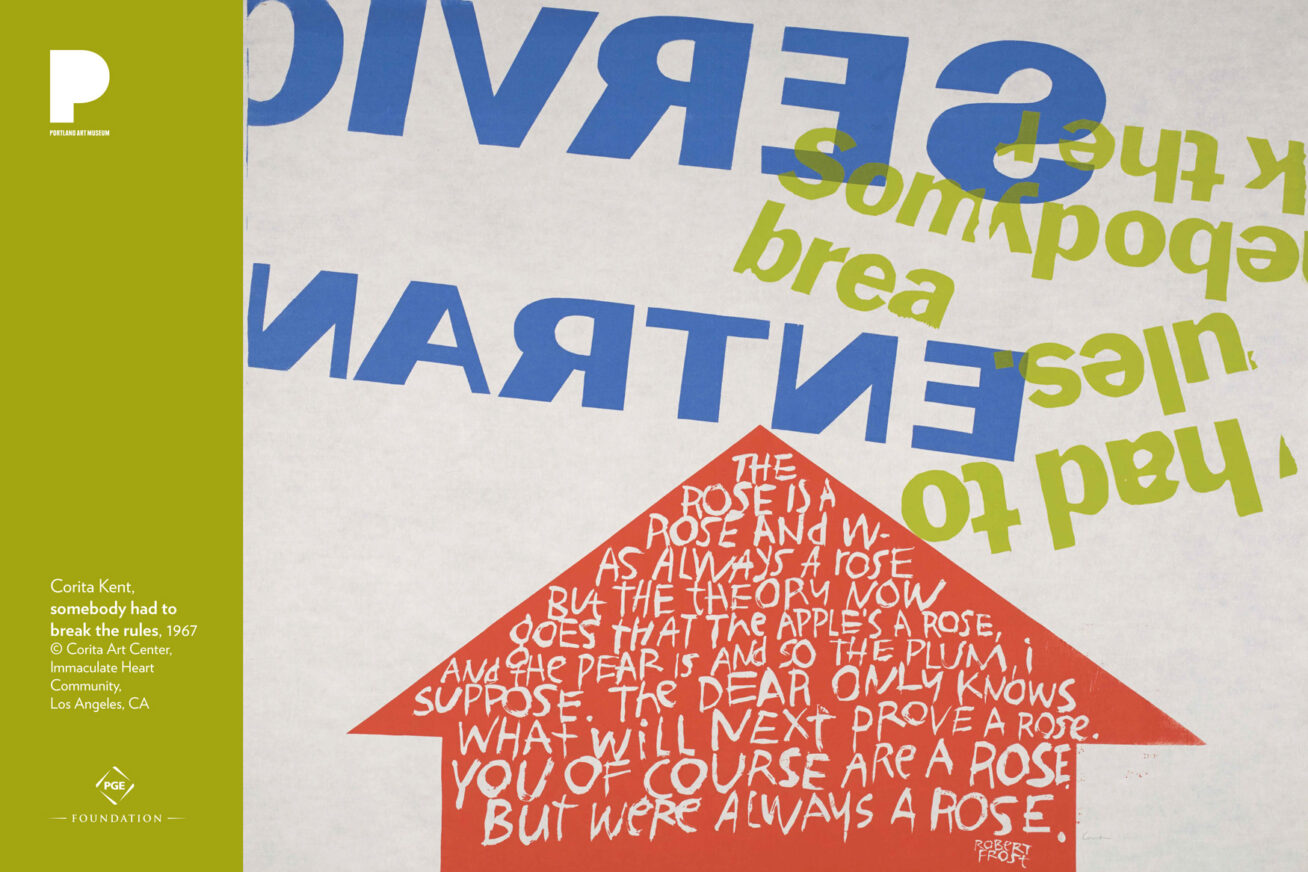
Corita Kent was an important artist, teacher, and advocate for social justice who gained international fame in the 1960s for her vibrant, revolutionary screenprints. Born Frances Elizabeth Kent in Iowa in 1918, Kent moved with her family to Hollywood in 1923. She joined the Immaculate Heart of Mary order at age 18, taking the name Sister Mary Corita. Kent earned her undergraduate degree at the Immaculate Heart College in 1941 and became a professor of art there in 1947. She was a demanding and highly creative teacher who constantly challenged her students to look deeply at the world.
In addition to teaching art classes, Kent organized “happenings” and lectured and traveled widely, all while producing nearly 700 screenprints over the course of her artistic career. She believed deeply in reform—of the Catholic Church, of society, and of politics—and used her art to engage viewers in her radical message of hope and love. Her playful, witty, and inventive Pop art of the 1960s brought Kent international renown; in 1967, she graced the cover of Newsweek magazine under the headline, “The Nun: Going Modern.” In 1968, at the height of her fame, she left Los Angeles and the Immaculate Heart order to live a secular life in Boston and begin a new chapter of her art and life.
This print dates from the height of Kent’s career, when she was deeply engaged with the world surrounding her. She soaked up the chaotic visual landscape of Los Angeles, believing that, in her words, “everything is sacred” and, therefore, worthy of examination. She appropriated commercial jingles, street signs, and supermarket advertisements and mixed them with scripture, poetry, and song lyrics. She bent, altered, and inverted text, breaking the established rules of design to such an extent that fellow artist Ben Shahn dubbed her a “joyous revolutionary.” Her work continues to inspire generations of graphic artists and designers.
In this work, Kent combined and subverted the traffic signs of freeway culture, unmooring them from their traditional, directional role. Here a red arrow embellished with a poem by Robert Frost competes with reversed signage for a service entrance. Meanwhile, the sliced-up slogan of Dash dishwashing liquid—“Somebody had to break the rules”—could stand for Kent’s own artistic manifesto for experimentation.
Discussion
- Corita Kent responded to the world around her by repurposing signs, images, and slogans as art. In this print, she borrows and reverses the words “service entrance” and lifts a slogan from Dash dishwashing liquid ads (“Somebody had to break the rules”). How do the meanings of these phrases change when Kent incorporates them into her composition? Does her art prompt you to think differently about the advertisement or sign? In what ways?
- Kent also incorporated noncommercial, literary sources into her art. Here, she reproduces Robert Frost’s 1928 poem “The Rose Family” over a red arrow. What is the meaning of this poem? Compare the first two lines to the last two. How is Frost playing with essence and metaphor here? How do Frost’s lines interact with the other phrases in Kent’s print?
The rose is a rose,
And was always a rose.
But the theory now goes
That the apple’s a rose,
And the pear is, and so’s
The plum, I suppose.
The dear only knows
What will next prove a rose.
You, of course, are a rose—
But were always a rose.
—Robert Frost, “The Rose Family.” In West-Running Brook. New York: Henry Holt, 1928.
Activities
The following activities are adapted from Corita Kent and Jan Steward, Learning by Heart: Teaching to Free the Creative Spirit, second edition. New York: Allworth Press, 2008.
Activity 1:
Look at a magazine in many ways—one way at a time—and write three lines about each point of view. Choose from the list below. You can select as many ways of looking as you have time for.
- Sociologically
- Historically
- Anthropologically
- As a parable
- Meditatively
- As a directory
- As a work of art
- As a fairy tale
- As a revolutionary treatise
- As humor
- As poetry
- As layout and design
- As lettering
- As political indoctrination
- As an instruction book
Activity 2:
Type out brief passages from books that you love. When you are finished, cut away the excess paper. Cut out headlines and articles from newspapers or magazines. Glue the typed words and newspaper/magazine clippings onto a piece of paper on cardboard. First glue a set of typed words, then a clipping, until you have used up all your typed words and clippings.
Read what you have put together and notice new meanings, connections, and relationships between the two kinds of words.
Activity 3:
The next time you go to the market take a notebook and write down 50 things about the trip—on the way there, in the parking lot, coming home.
List ten projects for which sources could be found at the market, not necessarily related to the buying and selling of food.
Make three- or four-line poems from the promises on the food labels.